Price Hike for ZET Tickets? Tomislav Tomasevic Hints at Increase
November the 19th, 2021 - ZET tickets could be a target for an increase as things in Zagreb's city administration shift considerably under a mayor who is very different indeed to the late Milan Bandic.
As Poslovni Dnevnik writes, the budget of the City of Zagreb next year should end with a surplus of 300 million kuna. This is perhaps the biggest sensation for the capital's budget, which was presented recently by Mayor Tomislav Tomasevic.
The budget will total 15 billion and 120 million kuna, which is an increase of one billion and one hundred million kuna when compared to last year. The reason is the costs of loans, interest and loans to banks and the state, which are 700 million kuna higher than last year, and the city government intends to cover those 700 million kuna with savings. The largest of them is the abolition of the parent-educator measure, and the plan there is to save as much as 283 million kuna. Other savings will be spent on salaries, fees, IT equipment, and material costs.
Total revenues will be higher by as much as one billion and 500 million kuna, and the biggest item in the increase in revenue is the sale of city property in the amount of 680 million kuna. Zagreb Mayor Tomislav Tomasevic spoke about everything recently as a guest on RTL Direkt.
"In four years, the previous government has accumulated a deficit of 1 billion and 300 million kuna and now we have to accumulate a surplus of 300 to 300 over the next four years to reduce any late payments because the accumulated deficit turned into overdue liabilities that we inherited. To reduce delays we need to go into a surplus. This is the first time the city budget has even planned a surplus,'' he said, adding that Zagreb needs to find room for a surplus to offset the accumulated deficit.
When asked about potential ZET ticket price increases, he said that his new administration would get to that and that huge subsidies were planned for ZET, the city's public transport system.
“We finance almost 80 percent of ZET's costs from the city budget. There will still be free tickets for socially vulnerable groups of pensioners and students,'' he said.
That said, it looks like ZET tickets are due to be more expensive.
"As for ZET tickets, we'll wait for the new management of ZET to come into the story. The budget includes investments, we're going to purchase 20 low-floor trams that we plan to finance from the NPOO, which is a value of 300 million kuna in the next four years,'' Tomasevic stated.
For more, make sure to check out our dedicated politics section.
ZET Syndicate Boss: Zagreb Public Transport Tickets to Increase in Price
October the 16th, 2021 - The price of Zagreb public transport tickets is set to increase as a decision is made at the helm of ZET (Zagreb Electric Tram).
As Poslovni Dnevnik writes, in a recent interview with HRT, the president of the ZET syndicate, Drazen Jovic, announced a rise in Zagreb public transport ticket prices due to rising energy prices.
"Given the prices of derivatives, the prices of gas, construction materials, and some kind of creeping inflation, it is quite clear that there will be and that there should be a correction in the prices of Zagreb public transport tickets," said Jovic.
"One ticket will probably cost around 8 kuna. It's difficult to calculate exactly how much these tickets should be, but yes, they'll probably be around 8 kuna, which would be approximately realistic given the current price increases," Jovic said. That said, most won't be happy with a 50% price increase on a 30 minute ticket, which currently costs a mere 4 kuna.
He added that the existing tickets of 4, 7 and 10 kuna should all be combined into one ticket with a single price, which is also likely to irritate many Zagreb public transport users who feel like they'll be being robbed of both time and money.
Jovic also said that ZET subsidies range on average from 500 to 700 million kuna a year and that the difference in tickets is subsidised.
"ZET will never have a ticket being sold at a real market price because it would be absolutely unacceptable to Zagreb public transport's end users," he added, despite the sentiment from many that this price hike in itself won't be very popular among the city's commuters.
"I think people should be quite honestly told that there will be a rise in prices," Jovic stated, adding that believes that the price of communal services is also set to increase.
''Considering the derivatives, and looking atthe overall situation, I think that the people of Zagreb should be honestly told that there will be a rise in prices on the horizon. This situation is certainly unsustainable in terms of utilities, and that ranges from cleanliness all the way to transportation itself,'' said Jovic.
-16For more on Zagreb's public transport system and what you can use it to see in the bustling capital, why not check out Zagreb in a Page in the language of your choice?
Zagreb Mayor: ZET Ticket Prices to Remain Unchanged for Now
September the 6th, 2021 - Zagreb Mayor Tomislav Tomasevic has been shaking things up in the post-Bandic Croatian capital following years of alleged mismanagement and scandals. As things alter and as the Zagreb cable car project continues to cause issues, Tomasevic has assured that ZET ticket prices are to remain the same - at least for now.
As Poslovni Dnevnik writes, on Sunday, the Mayor of Zagreb, Tomislav Tomasevic, said that for now, ZET ticket prices will remain unchanged and that they are doing everything they can to prevent any increase in the price of tickets for the use of the city's public transport system.
"For now, these ZET ticket prices will remain as they are. We're doing everything we can to prevent the increase in the price of public transport,'' Tomasevic told reporters at Ban Jelacic Square, where he participated in the action of the Ministry of Economy and Sustainable Development called #ZaZeleniSvakiDan/ForGreenEveryDay''.
He confirmed that ZET definitely does have debts, because, as he explained, it took out a loan of half a billion kuna for the realisation of the deeply problematic Sljeme cable car, loan installments are already needing to be paid, and there is no income yet. "So the cable car is a big weight for ZET's business," Tomasevic warned.
He explained that ZET, which is marking its 130th anniversary, operates in such a way that the vast majority of costs are covered directly from the city budget through a subsidy paid out to the city company.
The mayor says that this year, in order to cover the loss that will occur, which ZET didn't plan for, he will have to provide a larger amount for the subsidy in the rebalance of the city budget than was planned this year.
He didn't want to say what the amount of the subsidy will be and whether there will be a shift in the way ZET does things, and he announced that he will talk more about it next week when he will present the supplementary budget of the City of Zagreb.
He also announced that he would do everything to improve public transport in Zagreb, and called on people to use that transport as much as possible and leave their cars at home whenever they can in order to help protect the environment.
He says that they have talked to some ministers about the Sljeme cable car, but they haven't yet had time to talk to some of the people they need to. He also noted that they have an administrative dispute on their hands over the use permit for the planned Sljeme cable car and that the dispute will go on in court for some time yet.
However, regardless of the dispute, he announced that works will be done that will reduce the noise of the Sljeme cable car, because, as he pointed out, the cost of these works is lower compared to the cost that arises every month because the cable car isn't in function.
"So, it will be another new cost, but again not so much in relation to this cost that occurs every month because the cable car isn't moving and has no income," concluded Tomasevic.
For more, make sure to follow our lifestyle section.
Zagreb’s ZET Marks 130 Years of Public Transport in City
ZAGREB, 5 Sept, 2021 - Zagreb's public transport company ZET on Sunday marked its 130th anniversary in memory of 5 September 1891 when the first horse-driven tram carriage service started in the city.
Therefore the Zagreb Municipal Transit System or ZET (standing for the Zagrebacki Elektricni Tramvaj company) observes 5 September as the anniversary day of the beginning of the organised city transport system.
The first electric tramcar was put in service in the streets of Zagreb on 18 August 1910. In one year's time, the network of electric street cars replaced horse-driven trams.
In 1931, ZET included buses for the first time as the new mode of public transport in Zagreb. ZET operates a funicular from downtown to uptown Zagreb, which is the shortest funicular route in the world.
The ceremonies marking the 130 anniversary include a concert of pop songs aboard an open-top ZET bus.
This city company has 266 trams in its fleets, and 142 of them are low-floor trams. ZET has 480 buses.
The company transports more than a million passengers on a daily basis.
For more about Croatia, CLICK HERE.
ZET Public Transport Could Get New Multifunctional "Smart" Handrails
April the 14th, 2021 - Zagreb's ZET public transport system could be set to get its hands on some brand new multifunctional equipment which would boast similar services as some smart watches currently on the market.
As Poslovni Dnevnik/Marija Crnjak writes, there has been little to no tourism for not only Croatia but for the majority of the world over the last year, and Igor Knezevic, the owner of an agency for renting out apartments and events, had a choice of whether to sit at home being irritated and twiddling his thumbs or to come up with something new.
He chose the latter and a new challenge, a project that suits the times in which we live, which he believes has great potential in the country, but for outside of Croatia.
A pilot and engineer by profession, Knezevic designed the "smart handrail" Smart Medico intended for public transport, a device modelled on smart watches which measure a person's heart rate, blood pressure and body temperature. He is now in the final phases of the development of this project and is looking for partners with whom he could apply for money from European Union (EU) funds.
"As I normally deal with air transport and tourism, and all of that stopped because of the pandemic, I decided to dedicate myself to investing in the development of a socially beneficial project. Given the circumstances surrounding the coronavirus pandemic, it seemed to me that such a product could meet the interest of both the public and the public sector.
As an engineer, I independently developed and made a prototype device with 3D printing that is suitable for installation in vehicles, and we plan to enter the market this year,'' explained Igor Knezevic. His smart handrails can be placed in all public transport vehicles, could find itselt in the capital's ZET public transport system, and shows passengers the current condition of their body.
The product is protected and registered and is ready for production at a price of about 300-400 kuna per device. The device is not registered as a medical instrument, but serves instead as something useful for general users, and plays a similar role as the services offered by a smartwatch.
"A lot of public transport users don't use smartphones or smartwatches, nor do they have such applications which could boast similar services as our handrail can. On the other hand, market research has shown us that people are usually very interested in learning something about their current physical condition, which is why they're also frequent visitors to pharmacies that offer similar measurement services. These people are our potential beneficiaries,'' explained Knezevic, who is currently in the initial stages of talks with public institutions and companies that could be interested in cooperation.
As this is a socially useful product, intended for the general public, Knezevic believes that this is an excellent project for which he could apply for funds from the European Fund for Civil Society Development, and the project holders can be companies such as the ZET public transport system.
"So far, we've only informed them about what we have on offer and I expect that in the coming period there will be negotiations with ZET public transport, but also other carriers and other cities. They showed interest in our product in Graz, and Maribor is on our list for negotiations, to which we're just now sending out all the details about the product,'' he stated.
He explained that the handrail also boasts anti-theft protection, and after giving someone details about their body temperature and the like, it is automatically reset, so there is no possibility of data misuse. The Austrians, for example, could be tempted by such a device as they are interested in doing research on the state of health in the population using anonymous samples taken from trams and buses.
Knezevic is convinced that there will be interest in his innovation, and not only from Zagreb's ZET public transport, but from others too. He isn't intending on stopping there either, after the smart handrail, the development of a similar device will follow.
For more on Croatian innovative, make sure to check out Made in Croatia.
Zagreb to Get First Hydrogen Buses in Two to Three Years
ZAGREB, 4 March, 2021 - Zagreb should in two to three years get its first 20 fuel cell buses in public transport, an investment worth €25 million, it was announced on Thursday at the signing of a cooperation agreement between INA and the City of Zagreb on the introduction of hydrogen in public city transport.
President of the Management Board at the ZET city transportation company, Ljuba Romčević-Žgela, said that the agreement was between the City of Zagreb and Ina, as well as the City and ZET, on further investments in alternative fuels, that is, the purchase of hydrogen buses.
The signatories of the agreement have undertaken to invest in alternative fuels. More specifically, it is about the procurement of 20 hydrogen fuel cell buses, and the construction of a hydrogen fuelling station at ZET's depot in Podsused is also planned.
Žgela expects that the project will be implemented in the next two to three years, with the first year being spent on the preparation of technical documentation.
Head of City Office for Economy, Energy and Environment Protection, Mirka Jozić, underscored that this was the first project to start mass application of hydrogen in Zagreb and Croatia.
"We are creating a new market for this energy source of the future. The estimated value of 20 hydrogen buses and supporting infrastructure is €25 million, and this will be financed by non-repayable EU funds," she said.
According to her, ZET's bus fleet today consists of 441 buses with an average age of 10.9, which cover a total of 29 million kilometres a year. Over the past few years, she said, the fleet has been modernised, so a good number of buses run on gas.
INA Management Board member Niko Dalić said that hydrogen was a clean fuel, with no harmful gases, and that hydrogen vehicles did not make noise. He is satisfied that ZET and Zagreb have recognised the advantage of hydrogen.
Zagreb Public Transport Provider ZET Reducing Bus and Tram Lines
January the 17th, 2021 - The Zagreb public transport provider ZET has announced that it will be reducing the number of both buses and trams running on its network due to the current drop in demand across the Croatian capital.
As Poslovni Dnevnik writes, the Zagreb public transport provider ZET (Zagreb Electric Tram) reported that it will reduce its operational tram and bus lines due to the general reduction in traffic demand which is being seen at the moment.
ZET will cut its services for a relatively short period of time, more specifically from January the 18th until January the 29th.
"Due to the decision of the Ministry of Science and Education to hold distance learning for higher grades of children attending primary schools, secondary schools (with the exception of high school graduates) and colleges, traffic demand is expected to decrease and accordingly from the 18th to the 29th of January, the tram lines 2, 3, 4, 6, 7, 9, 11, 12, 13, 14 and 17 will continue to operate but according to an adjusted timetable on working days/week days.
Additionally, individual departures on the following bus lines will be reduced: 109, 115, 118, 121, 125, 172, 212, 224, 226, 231, 232, 269 and 281,'' the Zagreb public transport provider ZET announced in a recent statement, and N1 reported.
For the latest travel info, bookmark our main travel info article, which is updated daily.
Read the Croatian Travel Update in your language - now available in 24 languages.
Zagreb Trams - Iconic and Integral to Life in Croatia's Capital
November 20, 2020 – Today is the 20th anniversary of the completion of the Zagreb trams network. Namely, on this day in 2000, the last current line from Jarun to Prečko was opened. To celebrate, we take a look at the iconic, blue trams of Zagreb
It's all too easy to take for granted the things you see every day. That's certainly true of city residents in their feelings for Zagreb trams. As it currently stands, the Zagreb trams network was completed on 20th November 2000, when the existing line to Jarun was further extended to Prečko, which lies to the west of the city centre. In the two decades that have followed, Zagreb trams have cemented their place as an icon of the city, have helped changed the cityscape of Zagreb and have facilitated the friendships, education, careers, relationships and businesses of the Croatian capital over millions of journeys. All without much fanfare or celebration.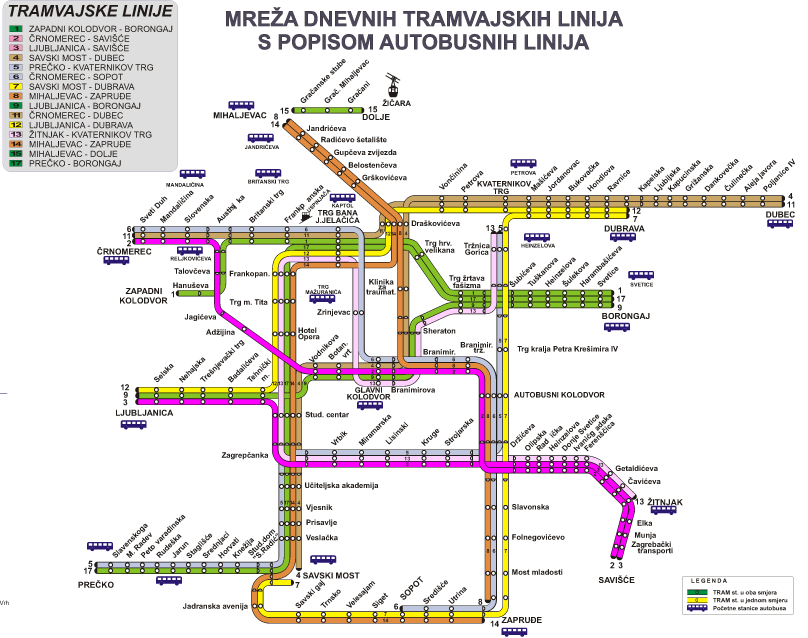 The Zagreb trams network
The Zagreb trams network
The Zagreb trams network consists of 15 lines which connect suburbs as far west from the centre as Prečko (8 kilomtres), as far east as Dubec (8 kilometres), north to Mihaljevac (3 kilometres) and south to Avenue Dubrovnik in Novi Zagreb (an additional line, running further south to Velika Gorica, servicing Zagreb Franjo Tudman airport, is planned). Throughout the night, four lines remain, connecting essential workers, night-time workers and late-night revellers (although they are sometimes replaced by night buses due to maintenance works).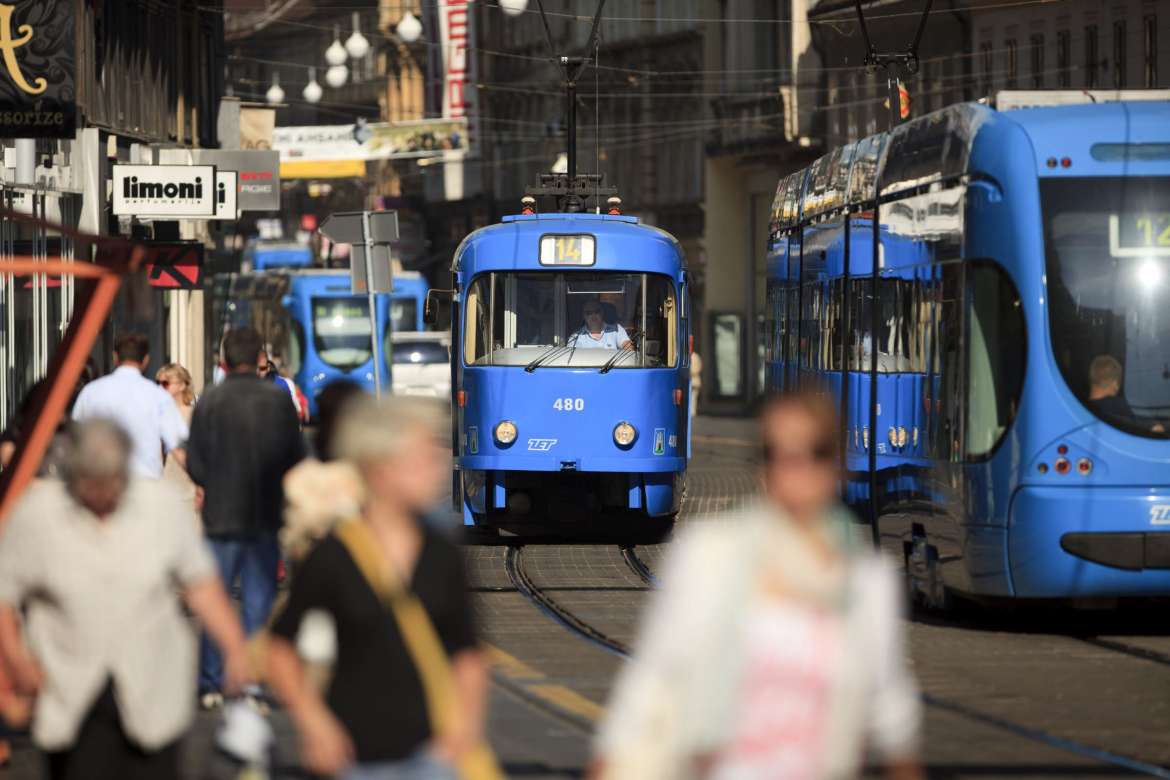 © Romulić & Stojčić
© Romulić & Stojčić
The completion of the line to Prečko catalysed the expansion of the westerly-lying suburbs of Špansko and Prečko. The change visited upon the rest of the city by the Zagreb trams network has been no less fundamental. Certainly, at weekends, Zagreb can confidently claim to be a 24-hour city because of its trams. Day or night, no place within the city suburbs is too far to reach because of Zagreb trams.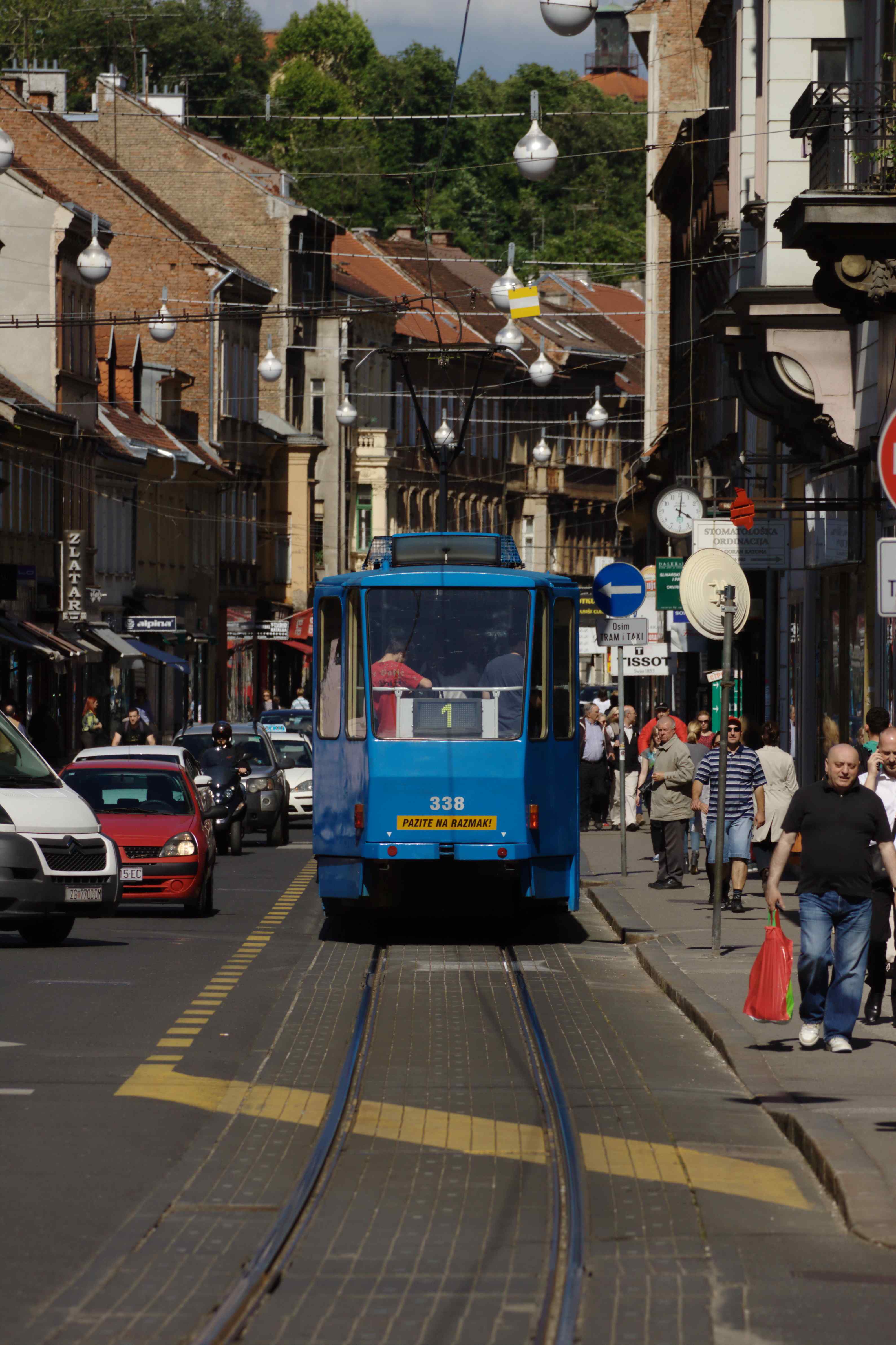 © Aktron / Wikimedia Commons
© Aktron / Wikimedia Commons
So reliable and well used are Zagreb trams that it's perhaps understandable why they are sometimes taken for granted. Whole generations now living in the city do not even know a Zagreb without a tram network. Its importance to all was put into sharp focus during the early part of 2020 when the Zagreb trams network was temporarily closed in response to the COVID-19 pandemic. Perhaps only then was the true scale of integration between Zagreb trams and the lives of city residents truly recognised. 'You don't know what you've got 'til it's gone.'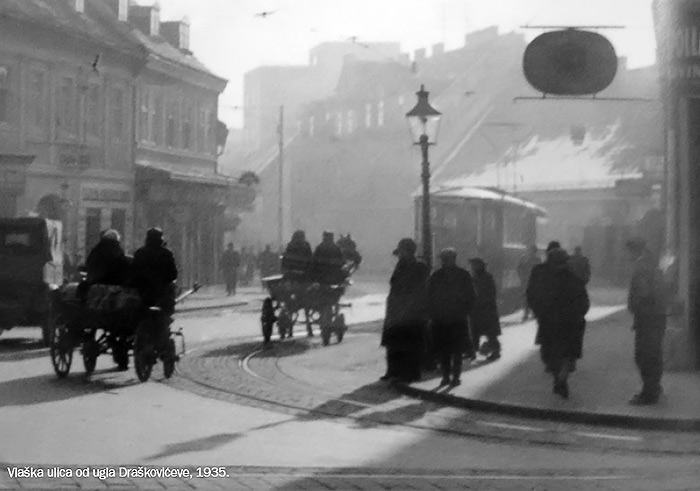 Zagreb trams on the corner of Vlaška and Draškovićeva streets in 1935 © Public domain
Zagreb trams on the corner of Vlaška and Draškovićeva streets in 1935 © Public domain
Lest we forget to give credit where credit is due, here are some interesting facts about Zagreb trams.
The Zagreb trams network was started in 1891 with the opening of the first line. Back then, the trams were pulled by horses - the electric tram didn't debut in Zagreb until 1910. The first journey started at the site of today's Technical Museum and the first track ran for some 8-kilometres. So fascinated were Zagreb residents with the introduction that some 20, 000 passenger journeys were made on the second day. The population of Zagreb at the time was 40, 000.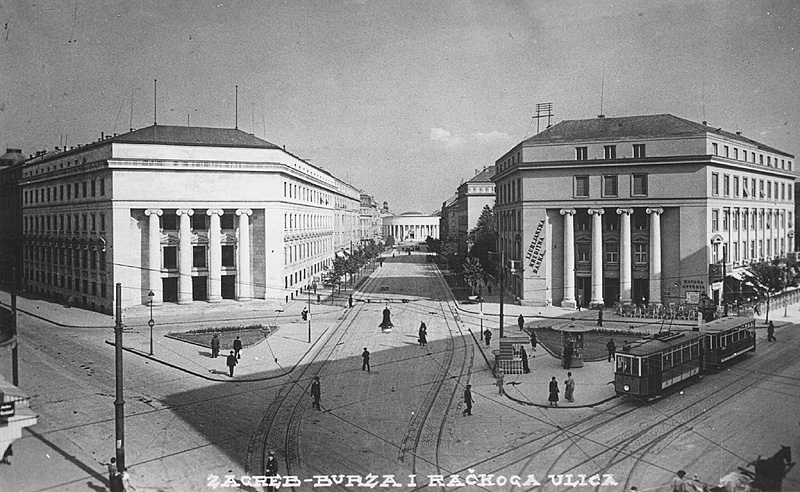 The route from Draškovićeva to Džamija in the 1930s © HappyV
The route from Draškovićeva to Džamija in the 1930s © HappyV
Osijek in Slavonia, east Croatia, was the first city in the country to have trams. The first international railway line into Croatia was built to facilitate holidays on the Kvarner coast, but the rail line ended in Rijeka. The upper echelons of Austro-Hungarian society who took this train were transported to their preferred destination – Opatija – by tram.
The most-modern low floor trams that now run in Zagreb were introduced in 2005.
There are two separate tram stations in Zagreb which have the same name – there are Heinzelova stations on the lines both to Savišće and Borongaj. The view from Džamija up to Draškovićeva and the cathedral in 1947 © Romák Éva
The view from Džamija up to Draškovićeva and the cathedral in 1947 © Romák Éva
The Zagreb trams network has 116.3 kilometres (72.3 miles) of metre gauge track. It is the same track all over the city, except for the line which runs north to Mihaljevac, which is unique. This line is both the fastest and the shortest in the Zagreb trams network. It services some of the most desirable Zagreb suburbs in which to live. But, of course. The inclusion of the Mihaljevac line brings the track total to 120 kilometres.
Children under the age of six do not require a ticket to ride on Zagreb trams.
There are six different types of tram currently running on the network. Zagreb residents have given nicknames to different models over the years – Đuro was named after a factory that made it, Bik, meaning bull, got its name because it was stronger than older models, Čeh was named after Czechoslovakia, the country where it was produced, Katica, Genšer and Zeko meaning bunny. Everyone likes the most modern trams in summer, because they have air conditioning but, in winter, city residents greet with joy the approach of older models on their route – the seats are heated to a toasty temperature.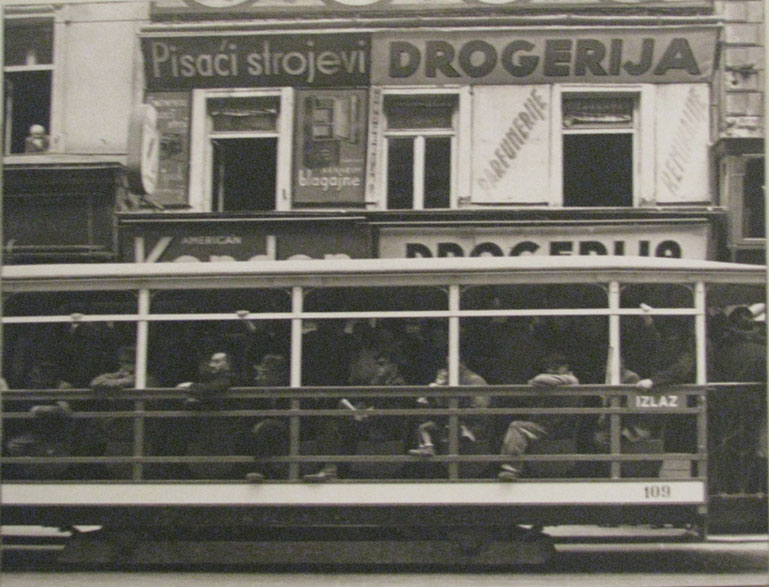 A photograph of how the open carriages of Zagreb trams used to look. The original of this photograph can be found in © Zagreb City Museum
A photograph of how the open carriages of Zagreb trams used to look. The original of this photograph can be found in © Zagreb City Museum
The longest single direction journey you can make on Zagreb trams is between Prečko in the west of the city and Dubec in the east. The journey takes around 76 minutes. You have to change tram only once to make this journey.
Apart from being the most environmentally friendly motorised public transport option in the city, the trams have massively contributed to Zagreb being a modern eco-friendly capital. Many city tram networks run down the middle of roads. While some lines in Zagreb are also placed here, many instead run at the sides of roads. This positioning – plus the way the lines sit in the road – make them problematic for cyclists. And this is partially the reason why Zagreb has 220 kilometres of dedicated cycle paths which exist not on the roads, like in other cities, but on the pavements.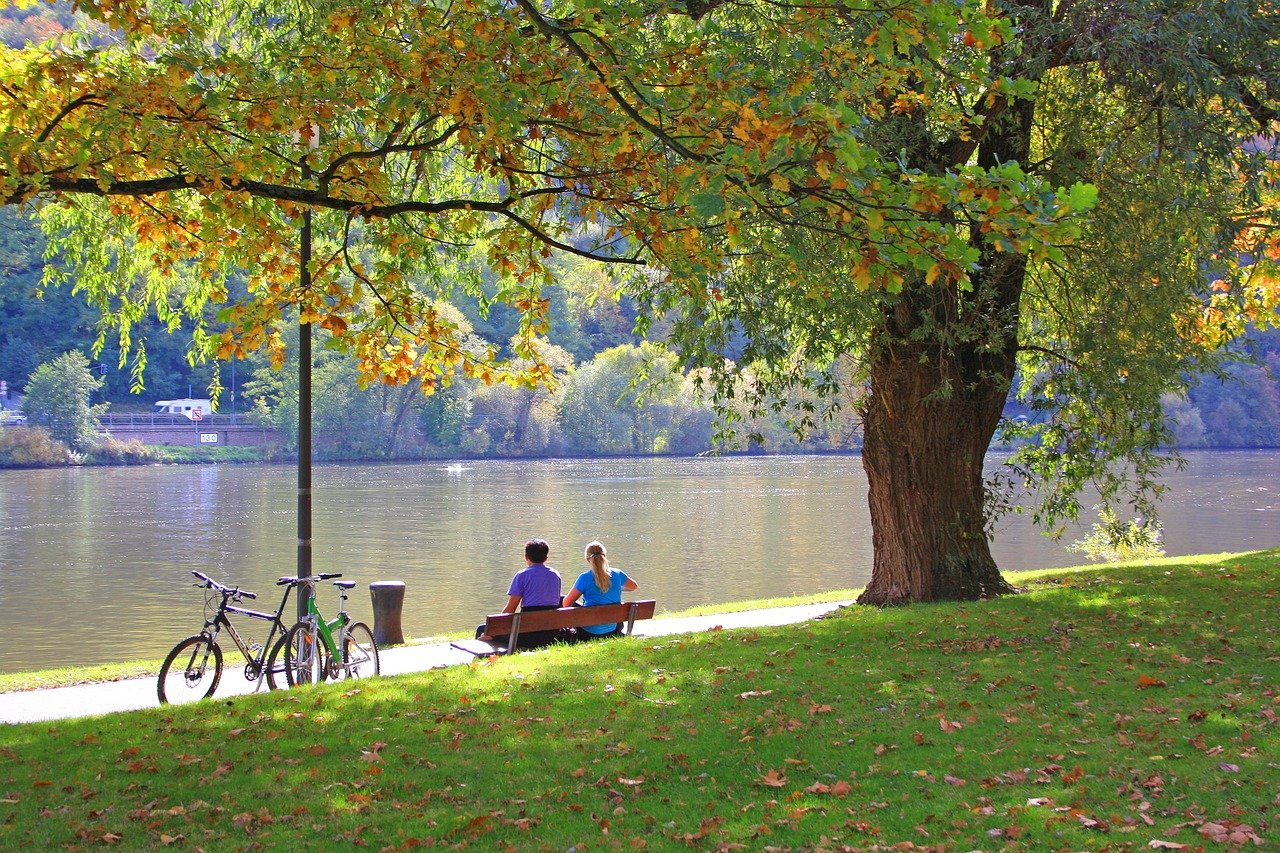 Zagreb's generous 220 kilometres of dedicated cycle paths come partially as a result of the positioning and construction materials of the Zagreb trams network © G Schneider
Zagreb's generous 220 kilometres of dedicated cycle paths come partially as a result of the positioning and construction materials of the Zagreb trams network © G Schneider
One of the world's worst tram accidents happened in 1954 on the Zagreb network. The tragedy took place on the old, steep stretch running near Mirogoj cemetery. Nineteen passengers were killed and thirty seven were severely injured.
During the day, each line runs on average every 5–10 minutes. Almost all stations on the Zagreb tram network sit on at least two lines.
Zagreb's tram network transported 204 million passengers in 2008.
A few years ago, the lowest fare tram ticket was 10 kuna. Zagreb trams were then often ridden by people without a ticket (and still are). The company who runs the tram network, ZET, decided to decrease the price of the lowest ticket to 4 kuna. Since doing so, many more people buy a ticket for Zagreb trams. You can travel for 30 minutes on any tram or trams with a 4 kuna ticket.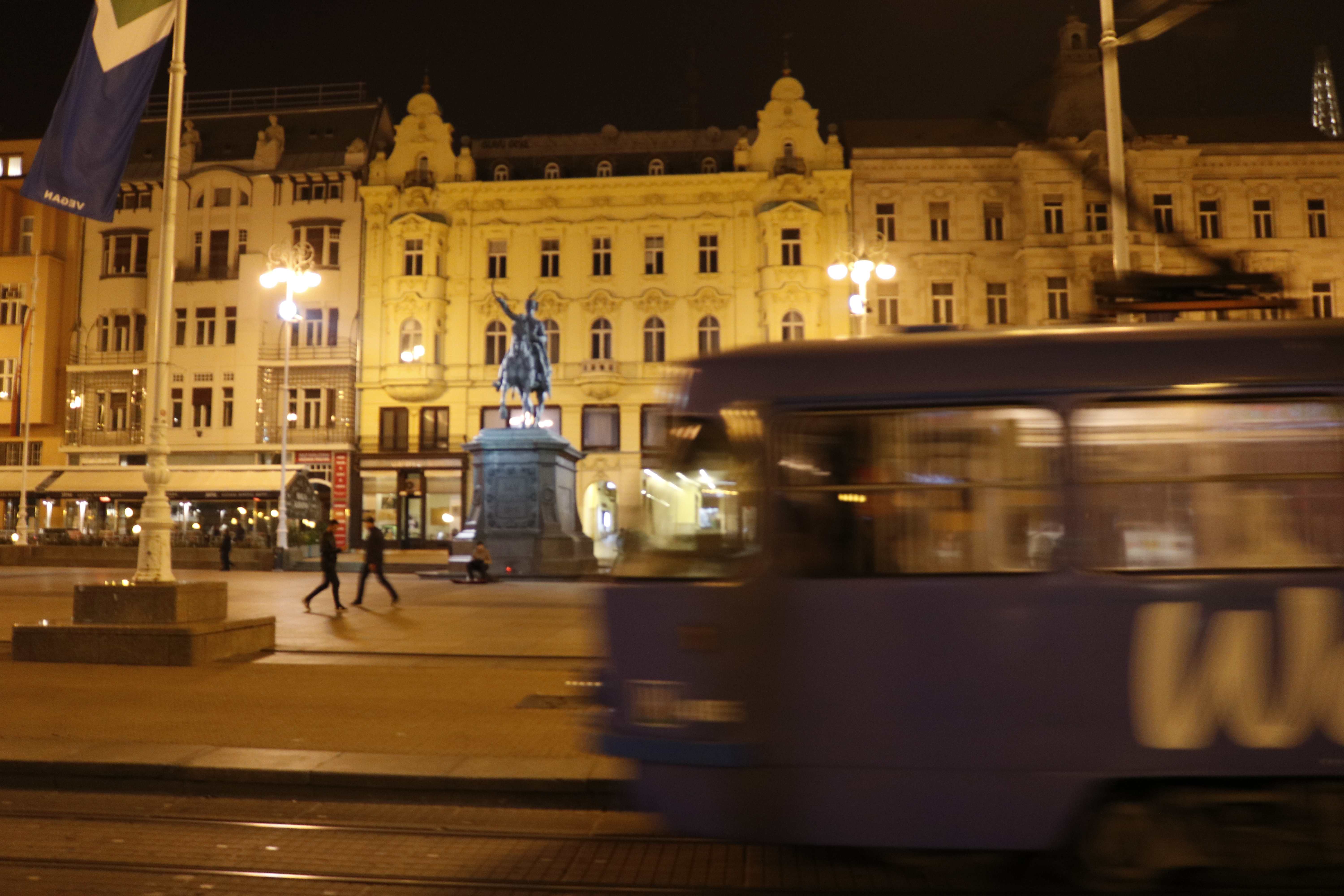 © Marc Rowlands
© Marc Rowlands
All uncredited photographs courtesy © ZET
ZET, ZG Holding, Zagreb Trade Fair Centre Post H1 Losses
ZAGREB, November 2, 2020 - Deputies in the Zagreb City Assembly on Monday adopted reports on the business results of the Zagreb Holding multi-utility conglomerate, the Zagreb Trade Fair Centre and the ZET city transportation company, showing that all three companies operated at a loss in the first half of the year.
Opposition deputies, who participated in the assembly's session that was held online, either voted against or abstained from voting on the companies' semi-annual reports. None of the deputies wanted to participate in a debate on the reports.
In the period from January to June, Zagreb Holding earned HRK 854 million in revenue while its expenditure totalled around HRK 970 million, which resulted in a pre-tax loss of some HRK 116 million.
ZET's revenue amounted to HRK 569 million while its expenditure totalled around HRK 581 million, resulting in a loss of HRK 12 million.
The Zagreb Trade Fair Centre's revenue totalled HRK 23 million and expenditures around HRK 29 million, which is a loss of six million, seven times more than in the same period of 2019 when the loss amounted to HRK 857,406.
The Assembly also adopted business reports of the Zagreb Innovation Centre and the Zagreb Waste Management Centre, which show that the two companies did not incur any losses.
ZET Re-Organising Zagreb Bus and Tram Schedules for All Saints Day
As Poslovni Dnevnik writes on the 26th of October, 2020, ZET has reported that they will re-organise the way things are run in regard to Zagreb bus and tram services with All Saints Day in mind. They stated that in this specific epidemiological situation, they are fully prepared to organise transportation through the days before, as well as on the actual days of the feast of All Saints Dat and on All Souls' Day.
"As of Friday, October the 23rd, the traffic situation on the lines whose routes usually pass by larger city cemeteries has been being monitored, and if necessary, additional transport capacities will be included in operation,'' they say from ZET.
The special regulation of public transport for the Zagreb bus and tram services will be in force on Saturday and Sunday (October the 31st and November the 1st), when other bus lines will be established on which transport will be free.
TRAM TRAFFIC
On All Saints' Day, which falls on Sunday, November the 1st, the Sunday tram schedule will apply in terms of tram traffic, but a larger number of trams will run on lines 4, 6, 7, 8, 11, 12, 14 and 17 compared to the usual Sunday schedule. In order to facilitate the transfer of passengers from the tram to the bus lines of the Kaptol terminal, depending on the number of passengers, an additional tram stop will be established in Ilica, next to Ban Josip Jelacic Square. On Saturday, October the 31st, tram traffic will run according to Saturday's schedule, but line 8 will also be in operation.
BUS TRAFFIC
When it comes to Zagreb bus services to the city's cemeteries, and depending on the influx and amount of people, ZET will include additional buses which will run on regular lines.
In order to establish quality traffic connections, on Saturday, October the 31st and Sunday, November the 1st, extraordinary bus lines will run as follows: Kaptol - Mirogoj, Kaptol - Mirogoj - Crematorium, Kvaternikov trg - Srebrnjak, while on Sunday, the 1st of November, the extraordinary lines Dubrava - Mirosevec, Dubec - Markovo Polje and Podsused centar - Poljanica - Gornja Bistra will also be in operation.
TRANSPORT TO MIROGOJ AND THE CREMATORIUM
The extraordinary Zagreb bus lines Kaptol - Mirogoj and Kaptol - Mirogoj - Krematorij will be established on Saturday and Sunday (October the 31st and November the 1st), from 08:00 to 21:00. On the lines Kaptol - Mirogoj and Kaptol - Mirogoj - Krematorij, buses will depart after they're full, without stopping at its regular bus stops, while the line to the crematoriom will stop near the roundabout zone by Mirogoj.
Going towards Kaptol, the buses will stop along the way at Mirogoj, ie at the temporarily established stop on Remetska cesta, in the area of the intersection with Mirogojska cesta.
One line will follow the route: Kaptol - Mirogoj: Kaptol - Zvonarnicka - Degenova - Grskoviceva - Bijenicka - Aleja Hermanna Bollea - Mirogoj. In return: Mirogoj - Mirogojska - Gupceva zvijezda - Vranciceva - Nova Ves - Kaptol.
Another line will follow the route: Kaptol - Mirogoj - Crematorium: Kaptol - Zvonarnicka - Degenova - Grskoviceva - Bijenicka - Aleja Hermanna Bollea - Mirogoj - Mirogojska - Remetska cesta - Crematorium. In return: Crematorium - Remetska cesta - Mirogojska - Gupceva zvijezda - Vranciceva - Nova Ves - Kaptol.
Passengers boarding buses for Mirogoj and the crematorium will be at Kaptol, at the stops of regular Zagreb bus lines. In the opposite direction, passengers will enter the buses to Kaptol at Mirogoj in front of the morgue, and at the crematorium, at the entrance of the regular bus line Kaptol - Mirogoj - Crematorium.
For the people who intend to visit the Mirogoj cemetery, for easier navigation, there is a free application (app) of the branch City Cemeteries, which also serves as a guide with which you can find out additional information about the history of the cemetery and famous people buried there.
The extraordinary Zagreb bus line 297 (Kvaternikov trg - Srebrnjak) will run on Saturday and Sunday, (October the 31st and November the 1st), from 08:00 to 21:00.
The line route will be as follows: Terminal Kvaternikov trg - Heinzelova - Kvaternikov trg - Domjaniceva - Srebrnjak - Bijenicka cesta (bus turnaround) and the same route will be taken in return. Buses running on the extraordinary line 297 will stop only at the Srebrnjak / Petrova ulica stop.
Passengers will enter the buses to Srebrnjak on the platform of line 201, and exit on the western part of Heinzelova street. Passengers will enter the buses for Kvaternikov trg in the area of the intersection of Bijenicka cesta with Srebrnjak street. Passengers will leave at Srebrnjak on Bijenicka cesta, east of the intersection with Srebrnjak street.
The Zagreb bus line 207 (Kvaternikov trg - Rim - Kvaternikov trg) will run on Saturday and Sunday on a partially altered route: Kvaternikov trg - the regular route to the intersection of Domjaniceva and Petrova streets - Petrova - Lascinska - Bijenicka and then along the usual route to Rim street. On the way back, the bus will take the same route.
Changes on Zagreb bus lines whose routes pass through areas with special traffic regulation:
Lines 106 (Kaptol - Mirogoj - Crematorium) and 201 (Kaptol - Kvaternikov trg) will not run on Saturday and Sunday (October the 31st and November the 1st), from 08:00 to 21:00, due to special traffic regulations.
Zagreb bus lines 203 (Svetice - Vinec - Kaptol) and 226 (Kaptol - Remete - Svetice) on Saturday and Sunday (October the 31st and November the 1st), from 08:00 to 21:00, will run on their regular route to the crematorium.
For the duration of the special traffic regulations, on Saturday and Sunday (October the 31st and November the 1st) from 08:00 to 21:00, the route of the regular bus line 105 (Kaptol - Britanski trg) will change. Towards Britanski trg, buses will run on the following route: Kaptol - Zvonarnicka - Degenova - Medvescak street - Gupceva zvijezda - Vranciceva.
A temporary stop will also be established in Vranciceva street, in the area of the intersection with Medvedgradska street. In the direction of Kaptol, the buses will run on their usual route.
For the latest travel info, bookmark our main travel info article, which is updated daily.
Read the Croatian Travel Update in your language - now available in 24 languages


